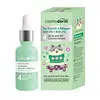What's inside
What's inside
 Key Ingredients
Key Ingredients

 Benefits
Benefits

 Concerns
Concerns

 Ingredients Side-by-side
Ingredients Side-by-side

Water
Skin ConditioningGlycerin
HumectantBiosaccharide Gum-1
HumectantNiacinamide
SmoothingPropylene Glycol
HumectantButylene Glycol
HumectantArbutin
AntioxidantDipropylene Glycol
HumectantOctanediol
Caprylyl Glycol
EmollientGlutathione
Aminopropyl Ascorbyl Phosphate
AntioxidantPanthenol
Skin ConditioningAcetyl Tyrosine
Skin ConditioningSaxifraga Sarmentosa Extract
Skin ConditioningPaeonia Suffruticosa Seed Oil
EmollientScutellaria Baicalensis Root Extract
AstringentNordihydroguaiaretic Acid
AntioxidantOleanolic Acid
Skin ConditioningDipotassium Glycyrrhizate
HumectantPolyacrylate Crosspolymer-6
Emulsion StabilisingHydroxyacetophenone
AntioxidantPEG-60 Almond Glycerides
EmulsifyingSodium Hyaluronate
HumectantCarbomer
Emulsion StabilisingCitric Acid
BufferingSodium Sulfite
PreservativeWater, Glycerin, Biosaccharide Gum-1, Niacinamide, Propylene Glycol, Butylene Glycol, Arbutin, Dipropylene Glycol, Octanediol, Caprylyl Glycol, Glutathione, Aminopropyl Ascorbyl Phosphate, Panthenol, Acetyl Tyrosine, Saxifraga Sarmentosa Extract, Paeonia Suffruticosa Seed Oil, Scutellaria Baicalensis Root Extract, Nordihydroguaiaretic Acid, Oleanolic Acid, Dipotassium Glycyrrhizate, Polyacrylate Crosspolymer-6, Hydroxyacetophenone, PEG-60 Almond Glycerides, Sodium Hyaluronate, Carbomer, Citric Acid, Sodium Sulfite
Ingredients Explained
These ingredients are found in both products.
Ingredients higher up in an ingredient list are typically present in a larger amount.
Biosaccharide Gum-1 is a sugar created by fermenting sorbitol (which usually comes from potato starch!). It is known for its soothing and moisturizing properties.
Manufacturer tests show this ingredient helped reduce irritation from lactic acid by almost half and kept skin hydrated long-term as a humectant
Beyond hydration, Biosaccharide Gum-1 gives formulas a silky, non-sticky feel.
This ingredient is gentle, versatile, and suitable for all skin types.
Fun fact: Similar sugars can be found naturally in fruits like apples and pears.
Learn more about Biosaccharide Gum-1Panthenol is a common ingredient that helps hydrate and soothe the skin. It is found naturally in our skin and hair.
There are two forms of panthenol: D and L.
D-panthenol is also known as dexpanthenol. Most cosmetics use dexpanthenol or a mixture of D and L-panthenol.
Panthenol is famous due to its ability to go deeper into the skin's layers. Using this ingredient has numerous pros (and no cons):
Like hyaluronic acid, panthenol is a humectant. Humectants are able to bind and hold large amounts of water to keep skin hydrated.
This ingredient works well for wound healing. It works by increasing tissue in the wound and helps close open wounds.
Once oxidized, panthenol converts to pantothenic acid. Panthothenic acid is found in all living cells.
This ingredient is also referred to as pro-vitamin B5.
Learn more about PanthenolPropylene Glycol is an odorless, colorless liquid. As a humectant, it helps skin retain moisture. It also aids in delivering active ingredients.
Another role of this ingredient is preventing a product from melting or freezing. Propylene glycol also adds antimicrobrial properties to a product, elongating product lifespan.
This ingredient is considered an organic alcohol and commonly added into both cosmetics and foods.
Those with sensitive skin or conditions may develop a rash when using this ingredient.
Learn more about Propylene GlycolWater. It's the most common cosmetic ingredient of all. You'll usually see it at the top of ingredient lists, meaning that it makes up the largest part of the product.
So why is it so popular? Water most often acts as a solvent - this means that it helps dissolve other ingredients into the formulation.
You'll also recognize water as that liquid we all need to stay alive. If you see this, drink a glass of water. Stay hydrated!
Learn more about Water